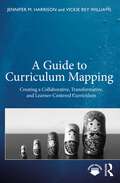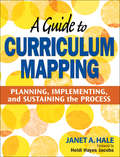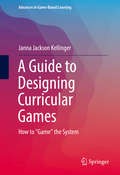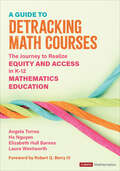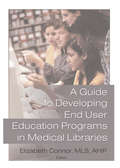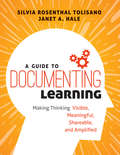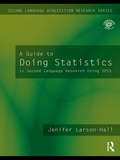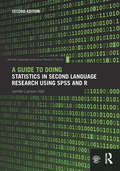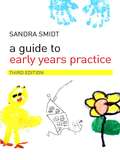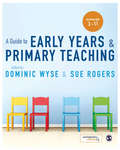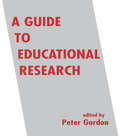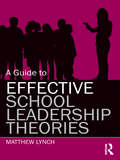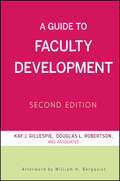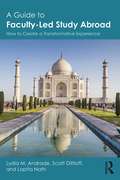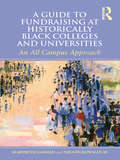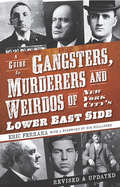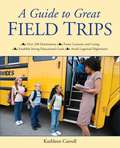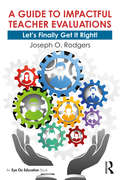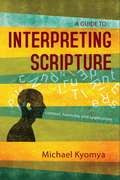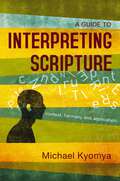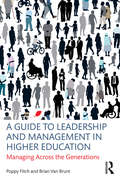- Table View
- List View
A Guide to Curriculum Mapping: Creating a Collaborative, Transformative, and Learner-Centered Curriculum
by Jennifer M. Harrison Vickie Rey WilliamsA Guide to Curriculum Mapping synthesizes teaching, learning, and assessment research with an innovative, inclusive, and comprehensive approach to effective curriculum design that centers student learning and evidence-informed continuous improvement. A Guide to Curriculum Mapping offers adaptable tools, resources, and templates that readers can customize to their own institutions and programs. The authors offer ways to document, synthesize, integrate, and visually represent how learning opportunities work together—whether within courses, across degree programs, or throughout an entire college or university. The authors have presented their integrated mapping approach to acclaim at conferences for close to a decade and have tested their use in programs large and small across the US, beyond systematically applying them at their home institution, the University of Maryland, Baltimore County (UMBC). This book enables educators—whether faculty, chairs, deans, administrators, educational developers, staff, or assessment leaders concerned with student learning and success—to think through the clarity, organization, and alignment of their programs for improving learning using learner-centered research.
A Guide to Curriculum Mapping: Planning, Implementing, and Sustaining the Process
by Janet A. HaleThis practical, step-by-step guide examines the stages of contemplating, planning, and implementing curriculum mapping initiatives that can improve student learning and create sustainable change.
A Guide to Designing Curricular Games: How to "Game" the System (Advances in Game-Based Learning)
by Janna Jackson KellingerThis book is a guide to designing curricular games to suit the needs of students. It makes connections between video games and time-tested pedagogical techniques such as discovery learning and feedback to improve student engagement and learning. It also examines the social nature of gaming such as techniques for driver/navigator partners, small groups, and whole class structures to help make thinking visible; it expands the traditional design process teachers engage in by encouraging use of video game design techniques such as playtesting. The author emphasizes designing curricular games for problem-solving and warns against designing games that are simply "Alex Trebek (host of Jeopardy) wearing a mask". By drawing on multiple fields such as systems thinking, design theory, assessment, and curriculum design, this book relies on theory to generate techniques for practice.
A Guide to Detracking Math Courses: The Journey to Realize Equity and Access in K-12 Mathematics Education (Corwin Mathematics Series)
by Angela Nicole Torres Ho Hai Nguyen Elizabeth Crawford Hull Barnes Laura Wentworth StreeterCreate a pathway to equity by detracking mathematics The tracked mathematics system has been operating in US schools for decades. However, research demonstrates negative effects on subgroups of students by keeping them in a single math track, thereby denying them access to rigorous coursework needed for college and career readiness. The journey to change this involves confronting some long-standing beliefs and structures in education. When supported with the right structures, instructional shifts, coalition building, and educator training and support, the detracking of mathematics courses can be a primary pathway to equity. The ultimate goal is to increase more students’ access to and achievement in higher levels of mathematics learning–especially for students who are historically marginalized. Based on the stories and lessons learned from the San Francisco Unified School District educators who have talked the talk and walked the walk, this book provides a model for all those involved in taking on detracking efforts from policymakers and school administrators, to math coaches and teachers. By sharing stories of real-world examples, lessons learned, and prompts to provoke discussion about your own context, the book walks you through: Designing and gaining support for a policy of detracked math courses Implementing the policy through practical shifts in scheduling, curriculum, professional development, and coaching Supporting and improving the policy through continuous research, monitoring, and maintenance. This book offers the big ideas that help you in your own unique journey to advance equity in your school or district’s mathematics education and also provides practical information to help students in a detracked system thrive.
A Guide to Detracking Math Courses: The Journey to Realize Equity and Access in K-12 Mathematics Education (Corwin Mathematics Series)
by Angela Nicole Torres Ho Hai Nguyen Elizabeth Crawford Hull Barnes Laura Wentworth StreeterCreate a pathway to equity by detracking mathematics The tracked mathematics system has been operating in US schools for decades. However, research demonstrates negative effects on subgroups of students by keeping them in a single math track, thereby denying them access to rigorous coursework needed for college and career readiness. The journey to change this involves confronting some long-standing beliefs and structures in education. When supported with the right structures, instructional shifts, coalition building, and educator training and support, the detracking of mathematics courses can be a primary pathway to equity. The ultimate goal is to increase more students’ access to and achievement in higher levels of mathematics learning–especially for students who are historically marginalized. Based on the stories and lessons learned from the San Francisco Unified School District educators who have talked the talk and walked the walk, this book provides a model for all those involved in taking on detracking efforts from policymakers and school administrators, to math coaches and teachers. By sharing stories of real-world examples, lessons learned, and prompts to provoke discussion about your own context, the book walks you through: Designing and gaining support for a policy of detracked math courses Implementing the policy through practical shifts in scheduling, curriculum, professional development, and coaching Supporting and improving the policy through continuous research, monitoring, and maintenance. This book offers the big ideas that help you in your own unique journey to advance equity in your school or district’s mathematics education and also provides practical information to help students in a detracked system thrive.
A Guide to Developing End User Education Programs in Medical Libraries
by Elizabeth ConnorExplore a wealth of ideas, insights, and approaches that can be used or adapted by any medical library!Curricular changes in the health professions, coupled with a growing acceptance of the Internet as a tool for daily living, have contributed to a climate of change and opportunity for health sciences libraries. A Guide to Developing End User Education Programs in Medical Libraries will help graduate students in library science, entry-level medical librarians, and experienced educators to understand best practices and to build, expand, and improve medical library-sponsored educational programs. A Guide to Developing End User Education Programs in Medical Libraries is designed to aid and inform professionals who develop, teach, or evaluate end-user education programs in health sciences libraries. Eighteen case studies represent the ideas and approaches of more than fifteen private and public institutions in the United States and the Caribbean. The studies focus on effective end-user programs for medical information electives, veterinary medicine programs, health care informatics, and evidence-based medicine, plus instructional programs for teaching residents, ThinkPad-facilitated instruction, and more. The guide also examines how several medical libraries have created and expanded their end-user education programs.The contributors to A Guide to Developing End User Education Programs in Medical Libraries are health sciences librarians from teaching hospitals, medical/dental/veterinary schools, and health professions-focused universities in a dozen U.S. states and the West Indies. Each of them is involved in designing, teaching, and evaluating user education. This book will help you educate students of medicine, pharmacy, physical therapy, dentistry, and veterinary medicine, plus residents and practicing health professionals. The educational objectives and approaches in the case studies include: clinical medical librarianship integrating informatics objectives into curricula developing credit and non-credit coursework distance learning using new and emerging technologies to improve instructionThe case studies in A Guide to Developing End User Education Programs in Medical Libraries follow a format similar to that of the structured abstract, including introduction, setting, educational approaches, evaluation methods, future plans, conclusion, and references. Some are illustrated with tables and figures. Several are supplemented by material in chapter-specific appendixes. Further information about specific classes, programs, or teaching philosophies is made available via Web sites featured in the book.Let this valuable guide help you-and your institution-take advantage of the opportunities available at this exciting time in the evolution of library science!
A Guide to Documenting Learning: Making Thinking Visible, Meaningful, Shareable, and Amplified (Corwin Teaching Essentials)
by Janet A. Hale Silvia Rosenthal TolisanoA new approach to contemporary documentation and learning What is learning? How do we look for, capture, reflect on, and share learning to foster meaningful and active engagement? This vital resource helps educators answer these questions. A Guide to Documenting Learning facilitates student-driven learning and helps teachers reflect on their own learning and classroom practice. This unique how-to book Explains the purposes and different types of documentation Teaches different “LearningFlow” systems to help educators integrate documentation throughout the curriculum Provides authentic examples of documentation in real classrooms Is accompanied by a robust companion website where readers can find even more documentation examples and video tutorials
A Guide to Documenting Learning: Making Thinking Visible, Meaningful, Shareable, and Amplified (Corwin Teaching Essentials)
by Janet A. Hale Silvia Rosenthal TolisanoA new approach to contemporary documentation and learning What is learning? How do we look for, capture, reflect on, and share learning to foster meaningful and active engagement? This vital resource helps educators answer these questions. A Guide to Documenting Learning facilitates student-driven learning and helps teachers reflect on their own learning and classroom practice. This unique how-to book Explains the purposes and different types of documentation Teaches different “LearningFlow” systems to help educators integrate documentation throughout the curriculum Provides authentic examples of documentation in real classrooms Is accompanied by a robust companion website where readers can find even more documentation examples and video tutorials
A Guide to Doing Statistics in Second Language Research Using SPSS
by Jenifer Larson-HallThis valuable book shows second language researchers how to use the statistical program SPSS to conduct statistical tests frequently done in SLA research. Using data sets from real SLA studies, A Guide to Doing Statistics in Second Language Research Using SPSS shows newcomers to both statistics and SPSS how to generate descriptive statistics, how to choose a statistical test, and how to conduct and interpret a variety of basic statistical tests. It covers the statistical tests that are most commonly used in second language research, including chi-square, t-tests, correlation, multiple regression, ANOVA and non-parametric analogs to these tests. The text is abundantly illustrated with graphs and tables depicting actual data sets, and exercises throughout the book help readers understand concepts (such as the difference between independent and dependent variables) and work out statistical analyses. Answers to all exercises are provided on the book’s companion website, along with sample data sets and other supplementary material.
A Guide to Doing Statistics in Second Language Research Using SPSS and R (Second Language Acquisition Research Series)
by Jenifer Larson-HallA Guide to Doing Statistics in Second Language Research Using SPSS and R, Second Edition is the only text available that demonstrates how to use SPSS and R as specifically related to applied linguistics and SLA research. This new edition is up-to-date with the most recent version of the SPSS software and now also includes coverage of R, a software program increasingly used by researchers in this field. Supported by a number of pedagogical features, including tip boxes and practice activities, and a wealth of screenshots, this book takes readers through each step of performing and understanding statistical research, covering the most commonly used tests in second language research, including t-tests, correlation, and ANOVA. A robust accompanying website covers additional tests of interest to students and researchers, taking them step-by-step through carrying out these tests themselves. In this comprehensive and hands-on volume, Jenifer Larson-Hall equips readers with a thorough understanding and the practical skills necessary to conducting and interpreting statisical research effectively using SPSS and R, ideal for graduate students and researchers in SLA, social sciences, and applied lingustics. For more information and materials, please visit www.routledge.com/cw/larson-hall.
A Guide to Early College and Dual Enrollment Programs: Designing and Implementing Programs for Student Achievement
by Russ OlwellThis is an accessible guide for school leaders and educators who seek to build, support, and expand effective early college and dual enrollment programs in their communities. One of the first books to bring together research in a practical way, this book is full of real stories, critical insights from leaders, teachers, and students, examples of what works and doesn’t work, and strategies to help students successfully make an important jump in their lives, putting them on track to post-secondary education and a career. Whether you’re starting a program from scratch or want to improve an existing dual enrollment and early college program, this book will provide you with the research base, tools, and resources to understand where you and your students fit into the national landscape, and provide guidance and inspiration on the journey to creating an effective program.
A Guide to Early Years Practice
by Sandra SmidtThis is a practical, accessible guide to early years practice. The author examines current theories about how children learn best and focuses on how we can support and extend the learning of young children. This fully revised edition discusses Birth to Three Matters, the new Childcare Bill and the development of children's centres, and has additional focus on the Foundation Stage Profile Packed full with case studies, the book offers: practical advice on how to successfully involve parents as equal partners in the education of their children guidance to ensure that the activities and support offered to young children will promote learning across a broad and balanced Early Years curriculum a focus on special needs, multiculturalism and multilingualism, play and culture, and the importance of interactions with adults and with peers. Essential reading for students on Early Years courses, this book is also invaluable for practitioners, who can use this text as the starting point for developing their own methods within the frameworks of statutory documents relating to Early Years education.
A Guide to Early Years and Primary Teaching
by Professor Dominic Wyse Professor Sue RogersHow do people become effective teachers? This is the textbook students need to support them on this journey, no matter their training route or whether primary or early years in focus. Through a unique pairing of academic research and teaching expertise, each chapter is collaboratively authored by an academic specialist and an experienced practitioner to provide a realistic and practical view of teaching children from years 3 - 11. The book combines all the major topics, theories and research students need to know, along with up-to-date policy and legislation. Inventive and practical learning aids and carefully crafted online resources will help readers to: Understand: helpful learning aims at the beginning and summaries at the end of every chapter guide students through each topic Apply: Spotlight on Practice features highlight real teaching examples, Putting it into Practice features provide advice on how key concepts can be employed in real life whilst classroom activities on the website provide further ideas for teaching Reflect on key concepts, as well as your own practice and values, through the refection points and author podcasts on the website outlining key issues to stimulate critical thinking Go further with informative annotated further reading at the end of every chapter, links to relevant websites integrated throughout, and carefully selected SAGE journal articles freely available on the website An essential textbook for use across all your primary and early years teaching courses - whether students are training to be lower/upper primary school teachers or early years practitioners, including those on undergraduate or postgraduate teacher training courses and employment-based routes.
A Guide to Early Years and Primary Teaching
by Professor Dominic Wyse Professor Sue RogersHow do people become effective teachers? This is the textbook students need to support them on this journey, no matter their training route or whether primary or early years in focus. Through a unique pairing of academic research and teaching expertise, each chapter is collaboratively authored by an academic specialist and an experienced practitioner to provide a realistic and practical view of teaching children from years 3 - 11. The book combines all the major topics, theories and research students need to know, along with up-to-date policy and legislation. Inventive and practical learning aids and carefully crafted online resources will help readers to: Understand: helpful learning aims at the beginning and summaries at the end of every chapter guide students through each topic Apply: Spotlight on Practice features highlight real teaching examples, Putting it into Practice features provide advice on how key concepts can be employed in real life whilst classroom activities on the website provide further ideas for teaching Reflect on key concepts, as well as your own practice and values, through the refection points and author podcasts on the website outlining key issues to stimulate critical thinking Go further with informative annotated further reading at the end of every chapter, links to relevant websites integrated throughout, and carefully selected SAGE journal articles freely available on the website This is an essential textbook for use across all your primary and early years teaching courses - whether students are training to be lower/upper primary school teachers or early years practitioners, including those on undergraduate or postgraduate teacher training courses and employment-based routes.
A Guide to Educational Research
by Peter GordonThis account of development in educational research is intended as a guide to possible research areas, both fundamental and policy-related, for students in colleges and higher education institutions, and should also be of interest to those engaged in curriculum planning and administration.
A Guide to Effective School Leadership Theories
by Matthew LynchEducational administrators know that leadership requires hundreds of judgments each day that require a sensitivity and understanding of various leadership strategies. Bridging the gap between the academic and practical world, A Guide to Effective School Leadership Theories provides an exploration of ten dominant leadership strategies to give school leaders a solid basis in theory and practical application. Demonstrating the advantages and drawbacks of each theory, readers are encouraged to discover the most appropriate strategy, or combination of strategies, that will best enable their school to achieve positive results. Each Chapter Includes: Introductory vignettes grounding the leadership theory in practice Discussion of the history, development, and utility of the strategy Research findings for further exploration of the theory End-of-chapter questions and activities designed to connect theory to practice This book is essential reading for aspiring and practicing school leaders who wish to have a better understanding of their leadership role. Providing a focused, up-to-date introduction to the current themes and dimensions of educational leadership, A Guide to Effective School Leadership Theories presents all the tools necessary to analyze and implement effective leadership in readers’ own settings.
A Guide to Faculty Development
by Kay William H. Bergquist Gillespie 160 J. Robertson Douglas L.Since the first edition was published, the dynamics of higher education and faculty development have greatly changed. A Guide to Faculty Development provides an introduction and a guide to faculty development as well as new topics like working with adjuncts, diversity, multiculturalism, assessment, and different issues associated with the various types of campuses. Sponsored by The Professional and Organizational Development Network in Higher Education, this revised and updated guide is essential for faculty developers and administrators newly involved as well as experienced in faculty development.
A Guide to Faculty-Led Study Abroad: How to Create a Transformative Experience
by Scott Dittloff Lydia M. Andrade Lopita NathA Guide to Faculty-Led Study Abroad provides practical information on the curricular and administrative considerations necessary to design and implement a course-based study abroad experience of the highest quality. From techniques for funding the trip, to legal considerations, curricular development, and cultural preparation, this book explains how to create a meaningful and valuable international experience in a variety of settings and formats. The study abroad novice and experienced faculty or administrator alike will benefit from this step-by-step guide on how to create a truly transformative, course-based study abroad experience.
A Guide to Fundraising at Historically Black Colleges and Universities: An All Campus Approach
by Marybeth Gasman Nelson Bowman IIIWinner of the 2012 CASE John Grenzebach Award for Outstanding Research in Philanthropy for Educational Advancement A Guide to Fundraising at Historically Black Colleges and Universities is a comprehensive, research-based work that brings the best practices and expertise of seminal professionals to the larger Black college environment and beyond. Drawing on data-driven advice from interviews with successful Black college fundraisers and private sector leaders, this book gives practitioners a comprehensive approach for moving away from out-of-date approaches to improve their institutions. This practical guide includes: An All Campus Approach—Discussion goes beyond alumni fundraising strategies to address the blended role that faculty, administrators, and advancement professionals can play to achieve fundraising success. Practical Recommendations—End-of-chapter suggestions for quick reference, as well as recommendations integrated throughout. Best Practices and Examples—Data-based content to strengthen fundraisers’ understanding of institutional advancement and alleviate uncertainties. Examples of Innovative Approaches—An entire chapter outlining successful innovative fundraising and engagement programs at various institutions. Extensive Appendices—Useful resources related to grant procurement, endowments, alumni giving, enrollment and retention, financial aid, and other helpful HBCU information. Both newcomers and seasoned professionals in the HBCU fundraising arena will benefit from the compelling recommendations offered in A Guide to Fundraising at Historically Black Colleges and Universities.
A Guide to Gangsters, Murderers and Weirdos of New York City's Lower East Side
by Eric Ferrara Rob HollanderNew York's Lower East Side is the birthplace of everything from organized crime to anarchist movements. In the nineteenth century, an influx of struggling immigrants seeking opportunity met the harsh realities of industrialization. Poverty and squalor fueled a vicious battle for power and political clout. Local historian Eric Ferrara reveals the wicked history of America's most infamous neighborhood, where the abounding graffiti is a testament to the soul and spirit of the slum.
A Guide to Great Field Trips
by Kathleen CarrollThe world is filled with educational possibilities - use it!This valuable resource explores every aspect of field trips, including their foundation in caring and curiosity, how leaders can establish and achieve sound learning goals, and how to avoid the headaches that too often accompany dozens of children and chaperones unleashed in a new environment. Properly organized, a field trip can provide students with opportunities to develop lifelong learning skills, increase personal responsibility, work cooperatively with others, and expand their worldviews.And field trips need not be full-day affairs to be valuable-even a short "trip" can provide a much richer learning experience than can be found though standard in-class instruction and serve as a welcome break from the weekday routine.A Guide to Great Field Trips outlines more than 200 ideas for valuable trips within the school, around the building and playground, and through the local neighborhood. It even offers ideas for virtual field trips on the Web. Readers can find tips on handling dozens of logistical issues related to field trips, including safety, transportation, permissions, fundraisers, grants, chaperones, meals, and more.
A Guide to Impactful Teacher Evaluations: Let's Finally Get It Right!
by Joseph O. RodgersWhat if everything we thought we knew about effective teacher evaluations was wrong? A Guide to Impactful Teacher Evaluations walks educators through an important shift in thinking about how to evaluate teachers: from systems focused on individuals and results to solutions focused on collectives and processes. Disregarding older, ineffective models that rely on faulty assumptions, this book embraces new approaches for measuring teacher competency that achieve valid assessment of effective teaching, teacher professional growth, and student learning. Chapters explore teacher evaluation systems based on professional learning community principles, confront the current system of teacher evaluation that has led to frustration, criticism, and disrespect, provide strategies for delivering new skills and supporting teachers’ growth, and include "Tips and Talking Points" for schools and districts. Outlining best practice and sharing actionable tools grounded in collaboration and teamwork, this book helps K-12 school leaders explore teacher evaluation that has a real and lasting impact on the profession and student learning.
A Guide to Interpreting Scripture: Context, Harmony, and Application
by Michael KyomyaAccording to Dr. Michael Kyomya, misconceptions about what the Bible actually says can breed confusion and false ideas about God and the Christian life. Therefore, it is critically important that you know how to interpret Scripture carefully. Dr. Michael Kyomya explains what interpretation is, why it is important, how to do it, and the pitfalls to avoid. He illustrates his points with examples from his own experience and from sermons he has heard in Africa. Dr. Kyomya makes it clear that interpretation is not just something for scholars, but also is useful when preparing a sermon or a Sunday school lesson, as well as in your own personal study of the Bible. The writing is simple and clear, and the illustrations are both amusing and informative. Full of ways to enrich personal study of the Bible, this guide will equip you with the knowledge and instruction you need.
A Guide to Interpreting Scripture: Context, Harmony, and Application (Hippo Ser.)
by Michael KyomyaAccording to Dr. Michael Kyomya, misconceptions about what the Bible actually says can breed confusion and false ideas about God and the Christian life. Therefore, it is critically important that you know how to interpret Scripture carefully. Dr. Michael Kyomya explains what interpretation is, why it is important, how to do it, and the pitfalls to avoid. He illustrates his points with examples from his own experience and from sermons he has heard in Africa. Dr. Kyomya makes it clear that interpretation is not just something for scholars, but also is useful when preparing a sermon or a Sunday school lesson, as well as in your own personal study of the Bible. The writing is simple and clear, and the illustrations are both amusing and informative. Full of ways to enrich personal study of the Bible, this guide will equip you with the knowledge and instruction you need.
A Guide to Leadership and Management in Higher Education: Managing Across the Generations
by Brian Van Brunt Poppy FitchA Guide to Leadership and Management in Higher Education shares an innovative approach to supervision, leadership, and management in the higher education workplace. Drawing from humanism and positive psychology, Fitch and Van Brunt weave together a compelling narrative for managing employees across generational differences. This book shares key leadership lessons and advice on how to inspire creativity, increase efficiency, and tap into the talents of your diverse, multi-generational staff. This guide offers practical and detailed advice on establishing new relationships, setting expectations, encouraging accountability, addressing conflict, and supervising difficult staff. Focusing on how to build and strengthen connections through genuineness and empathic caring, this book provides important guidance for today’s college and university leaders.
